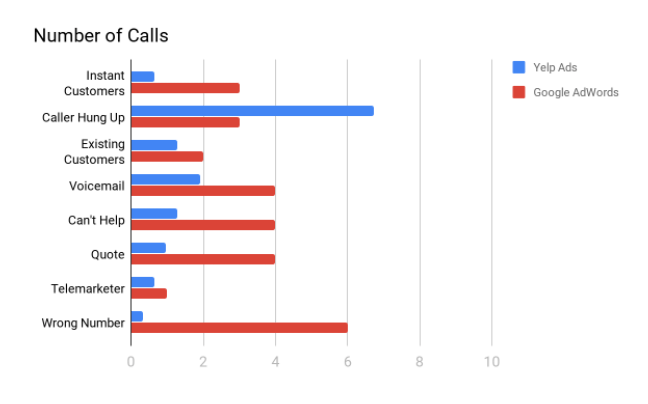
As someone who works regularly with small businesses, I am frequently asked: “Should I advertise on Yelp”?
Since this came up again recently, I thought I would share my insights and experience in hopes my answer helps someone else.
Yelps makes it hard
The last person asking about Yelp owns a European auto repair garage in Florida. They were spending $700 a month on Yelp ads and wanted to know what kind of ROI it was driving.
It is a very fair question but a hard one to answer since Yelp doesn’t make it easy for a business owner to understand what happens as a result of the ads. They only show you impressions and clicks but nothing else. This is kind of surprising given the amount of free data they provide with a listing. (This may be changing as Yelp this week shared the results of an attribution trial it recently conducted.)

If a business claims their listing on Yelp, they can see how many mobile calls they get and how many clicks were made to the website. However, when you advertise with them, they don’t break this down and tell you how many of those actions were a result of the ad itself.
This raised a huge red flag for me, I’ve found when media sellers leave out information, it’s not a good sign.
Yelp ROI
To figure out the ROI from Yelp ads, I first needed to estimate the increase in leads that happened after the ads started.
To calculate this, I looked back historically for two years and saw they had a total of 964 “leads” from Yelp according to the metrics inside their listing’s dashboard. I then modified what I was going to count as a lead since Yelp’s definition of a lead and my definition is vastly different. Here is what I included and the rounded percentage of Yelp-defined leads that they represented:
- Mobile Calls (21%)
- Clicks to Website (10%)
- Messages (4%)
I did not include:
- Directions & Map Views (58%)
- Calls to action clicks (2%)
- Uploaded photos (1%)
- Bookmarks (3%)
I excluded the directions metric because I don’t think someone clicking the map counts as a lead. If Yelp had separated these two things and included the number of just those who sought driving directions, that would be much more helpful.
Additionally, people don’t generally just drive up to a European auto repair garage without an appointment, so the people getting directions would most likely be duplicates of the people that called.
Since I was only considering 35% of Yelp leads to be real leads, I was left with a total of 50 leads in a three month period. However, not all these leads were from ads.
When you start advertising, you are still getting a ton of organic traffic from Yelp regardless of the ad. To estimate the amount that was from the ad, I looked at the previous three months and saw they got 34 leads before they started advertising.
Because of this, I concluded they saw an increase of 16 leads (32% increase) in the three months they had been advertising.
The real number of leads
After my careful calculation, I still felt like the number was missing something. Knowing someone clicked to your website or clicked on your phone button doesn’t mean they should be counted a lead. Yelp doesn’t track how many total calls you get directly from the listing; they only count “click-to-call” on mobile.
I felt this was probably causing me to undercut the real ROI quite a bit. For this reason, we decided to switch the phone number on the Yelp listing for a couple of months and track and record every call that came in. We added the new tracking number as a secondary phone number in Google My Business to make sure it didn’t mess up any consistency with the Name-Address-Phone Number (NAP).
During January 2018, the auto repair garage received 50 calls from the Yelp number from 43 unique callers. That number might sound high, but to classify which were actual leads, I listened to every call.
Here’s who called:

- 21 callers hung up or didn’t even record anything. These could have been misdials, robocalls or wrong numbers.
- Four callers were existing customers.
- Six callers went to voicemail after hours and didn’t leave a message.
- Four callers were looking for a service they didn’t offer.
- Three callers were leads looking for quotes.
- Two callers were leads that turned into customers on the call because they booked a service appointment.
- Two callers were telemarketers.
- One caller said they had the wrong number.
Based on this, they got a total of five new leads from calls plus one additional lead that filled out a contact form on their website. Since we previously saw Yelp ads increased their leads by 32%, that works out to be two new leads that came from a $700 ad spend, or a cost of $350 per lead.
Yelp ads ROI vs Google AdWords
To determine if that’s a good cost per lead, I wanted to compare it to the Google AdWords account we were running for them. Including our management fee, they spent $1,171.64 on Google AdWords in January. They received 36 calls from 26 unique callers from these ads.
The calls broke down like this:
- Three callers were leads that turned into customers on the call because they booked a service appointment.
- Six callers were calls that had the wrong number. Most of these were looking for a specific dealer.
- Four callers were looking for a service they didn’t offer.
- Four callers were leads looking for quotes.
- Four callers went to voicemail after hours and didn’t leave a message.
- Three callers were hung up or didn’t even record anything. These could have been misdials, robocalls or wrong numbers.
- Two callers were existing customers.
- One caller was a telemarketer.
Based on this, they had a total of seven callers that were leads, along with four additional leads that submitted a contact form on their website.
This leaves a total of 11 leads from a $1171 ad spend or $106 a lead. Yep, their cost per lead on Yelp is 3.3 times higher compared to Google AdWords!
In conclusion, Yelp ads might be a good option if your customer lifetime value is high enough to justify spending a lot more per lead than you would elsewhere.
No matter what you do, don’t trust the data you see on the dashboard and make sure you test the actual quality of the calls you’re getting — because a call isn’t the same thing as a lead.
Opinions expressed in this article are those of the guest author and not necessarily Search Engine Land. Staff authors are listed here.
